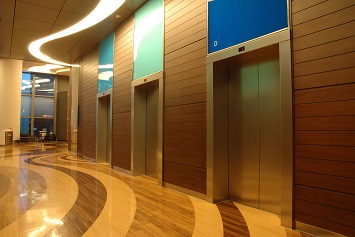There comes a time in every elevator’s life when it no longer makes financial or logistical sense to continue repairing the same components year after year. Service calls get expensive, replacement parts become harder to find and the time the elevator spends out of service ends up exceeding its time in operation. In most cases, the best solution is elevator modernization. Elevator modernization decreases energy consumption, increases property values and improves overall passenger safety. But is it the right move for your elevators? Here’s everything you need to know.
When to Consider Elevator Modernization
How old is your elevator? Hydraulic elevators typically have 20 to 25-year lifespans while overhead traction elevators have lifespans of about 30 years. Machine room-less (MRL) traction elevators have the shortest lifespans (10 to 15 years) due to their reliance on computerized controllers and lighter duty materials.
Once an elevator approaches or exceeds its lifespan, components begin to wear, and repairs become more expensive. Replacement parts become obsolete, expensive or difficult (if not impossible) to find, and the harder it is to find parts, the longer the elevator will be out of service. These disruptions can be a nightmare for both building owners and elevator passengers, especially in high-traffic buildings like hospitals, hotels and business centers.
Qualified elevator contractors will be able to identify when a system is approaching the end of its usable lifecycle in order to develop a modernization strategy. Modernization isn’t a process that can be rushed; there is a significant amount of planning involved. The sooner a building owner prepares for modernization, the easier the process will be.
When to Continue with Repairs
Although age is a main reason to upgrade and modernize an elevator, the overall usage of the equipment should be taken into consideration. A 20-year old elevator that is used only a few times per week may have a longer lifespan than one that is used dozens of times per day.
Whatever the case, make sure you have an elevator maintenance plan. This is a monthly agreement that includes routine, top-to-bottom inspections and service for your elevators. A plan like this is essential in that it keeps your equipment and your passengers safe, while also helping you avoid incredibly high repair costs.
The biggest advantage of an elevator maintenance plan is that it’s intended to minimize risk for the elevator owner. Keep in mind that not all maintenance plans are created equal. You’ll need to verify your terms to see if parts, repairs and unscheduled service calls are included. This is typically covered by most Full Maintenance Agreements, but the parts could be billable in lower plan tiers.
The Elevator Modernization Process
Every elevator modernization is unique, so the process will look different for each system. Generally, the following components are targeted in the modernization process:
- Control systems
- Wiring
- Fixtures
- Power units
- Door operators
- Valve assemblies
- Hoisting machines
- Motor generator sets
- Counterweight frame and fillers
Planning & Logistics
Modernization is a significant undertaking for any building. Here are a few logistical considerations to keep in mind:
- You’ll need a licensed elevator contractor to complete the work.
- You’ll need to secure local and state permits before modernization work can begin.
- You should have an understanding of the project schedule and the elevator downtime.
- Work may be required by other trades for fire alarm systems, electrical panel upgrades, HVAC systems, etc.
Energy Efficiency
Modernization can also increase the energy efficiency of your elevators, which typically account for 2% to 5% of a building’s total energy consumption. Today’s elevator technology is lightyears ahead of what it was 30 years ago — everything from lighting to the electrical system can be upgraded to help you cut energy costs. For example, converting a DC motor to an AC motor will require less energy and produce less heat, leading to lower electricity bills and a reduction in BTU loading.
Code Compliance
There’s a good chance that if an older elevator is in need of significant upgrades, it’s probably not up to date with the latest codes. Safety standards, fire codes and Americans with Disabilities (ADA) guidelines change every few years. Your modernization plan should include bringing your system up to the most recent codes for your city and state.
There is also the National Elevator Code from the American Society of Mechanical Engineers (ASME), which sets the standards for the design, construction, installation, operation, inspection, testing, maintenance, alteration (modernization) and repair of elevators. Most states and many major cities in the U.S. follow ASME’s guidelines. If you are unsure if your elevators are up to date on any codes, contact your local elevator service provider.
Timeline
The scope of your modernization will determine how long the process takes. A standard two to three-stop hydraulic elevator may have downtime of four weeks. A high-rise traction elevator would take longer, typically 10 to 12 weeks.
Types of Elevator Modernization
Cab Renovations
If an elevator is mechanically sound but could use a design refresh, renovation is recommended. You might consider this option if your building is going through aesthetic upgrades and you want the elevator cab to match.
Cab renovations are purely for aesthetic purposes; no mechanical upgrades will be made. Some of the most common cab renovations include:
- Doors
- Lighting
- Call buttons
- Elevator cab flooring
- Ceiling panels
- Wall panels
There are also quick renovations building owners can make to improve passenger safety. In the age of COVID-19, more and more buildings have incorporated room, door and elevator graphics to clearly communicate new wayfinding and social distancing guidelines. There is also the CASPR 200e, a continuous disinfecting technology designed for elevators, that can be installed to kill airborne and surface-level pathogens, including bacteria, viruses, mold, odors and volatile organic compounds (VOCs).
Stand-Alone Component Upgrades
Stand-alone mechanical upgrades are a quick way to make small, but necessary, improvements. Your technicians will repair or replace one part at a time, which can also make this process a bit more cost effective in the short-term.
If you choose stand-alone upgrades, expect certain enhancements to trigger other needs. For example, replacing controllers may affect your signal fixtures.
Full Elevator Modernization
Full elevator modernization is a complete system upgrade. All non-structural components are replaced to improve the system’s operation, energy consumption, safety and ride quality. Many full modernization projects also include cab renovations.
When an Elevator Should Be Replaced
There are certain situations where the best (or only) option is to replace the entire elevator. One example of this situation would be an old freight car found in a historic mill building. This elevator could still have wooden rails! Another case would be if the purpose of the elevator needs to change, such as converting a freight elevator into a passenger elevator.
Elevator replacement involves gutting the entire system and replacing it with a brand-new one, and it requires more money, time and permitting than modernization. If you don’t have to replace the entire system, modernization is the best way to improve your elevator.
Modernization is certainly an investment, but it’s one that pays off. The process can increase the value of your building, improve tenant satisfaction, increase safety and improve energy efficiency. It’s also a smart way to ensure that your systems are operationally prepared to handle another 20+ years.
 Ryan Hussey is VP of Operations for Stanley Elevator. In that role, he oversees the field, construction, and modernization teams. Hussey’s resume includes over 10 years of first-hand experience in elevator field service, project management, surveying, estimating and warehouse operations. Ryan Hussey is VP of Operations for Stanley Elevator. In that role, he oversees the field, construction, and modernization teams. Hussey’s resume includes over 10 years of first-hand experience in elevator field service, project management, surveying, estimating and warehouse operations. |

